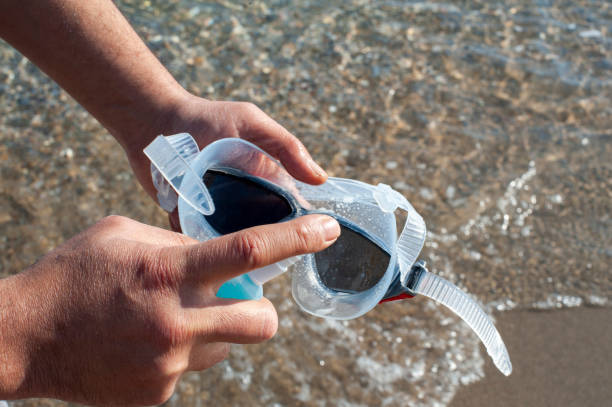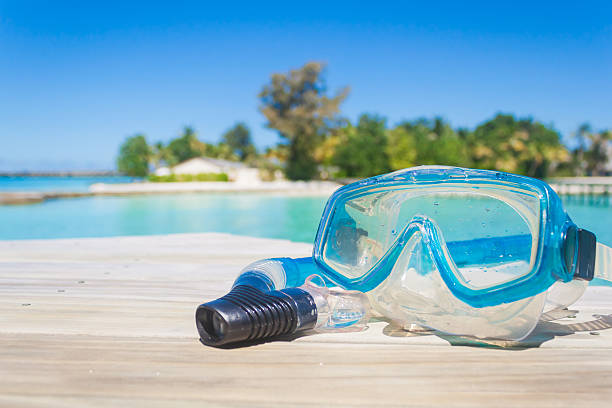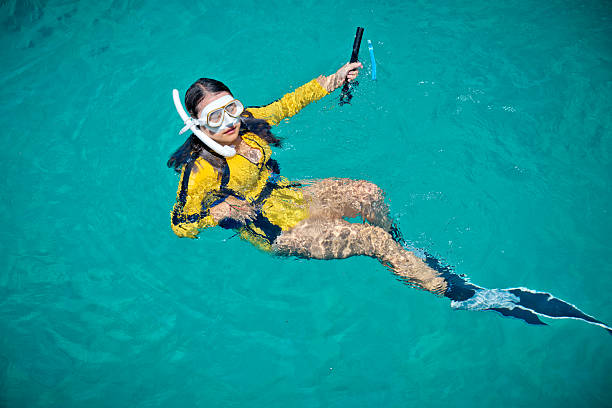La natation est une activité intemporelle appréciée par tous, quel que soit votre âge ou votre niveau de forme physique. Que vous soyez débutant ou nageur expérimenté, plonger dans une piscine ou glisser en eau libre peut être revigorant et bénéfique pour votre santé et votre bien-être. Dans ce guide complet, nous explorerons les différents aspects de la natation : ses bienfaits pour la santé, les différents styles de nage, l'équipement et le matériel, un guide étape par étape pour apprendre à nager, ainsi que les précautions et conseils de sécurité importants à garder à l'esprit. Alors, c'est parti !
Les bienfaits de la natation pour la santé
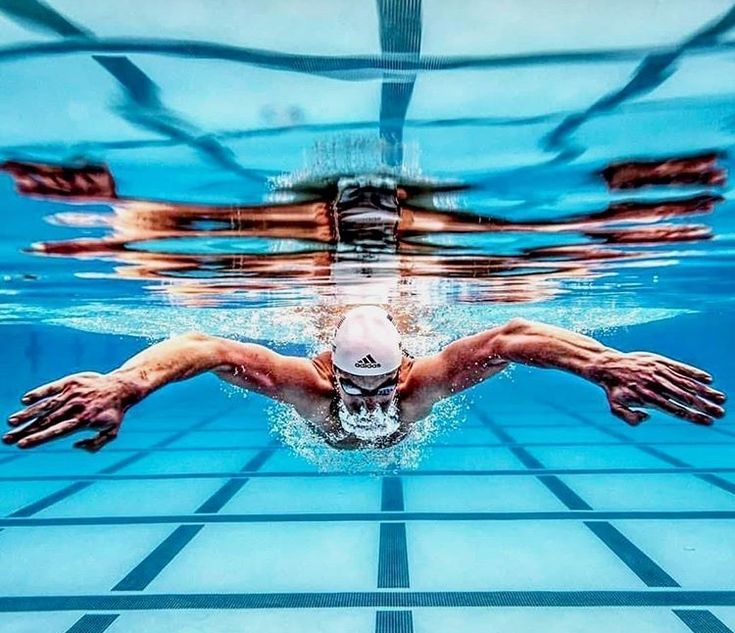
source : pinterest
La natation est reconnue comme une activité physique à faible impact, alors que fait la natation pour votre corps ?
Exercice cardiovasculaire à faible impact
La natation offre un entraînement cardiovasculaire à faible impact et doux pour les articulations, ce qui en fait un exercice idéal pour les personnes souffrant d'arthrite ou en convalescence. La flottabilité de l'eau réduit la tension sur le corps, vous permettant de bouger librement et sans douleur tout en augmentant votre rythme cardiaque. Les mouvements rythmiques et continus de la natation sollicitent votre système cardiovasculaire, améliorant ainsi votre santé cardiovasculaire globale.
Entraînement complet du corps
L'un des avantages remarquables de la natation est qu'elle sollicite simultanément plusieurs groupes musculaires, vous offrant ainsi un entraînement complet du corps. Que vous pratiquiez la nage libre ou la nage papillon, vos bras, vos jambes, votre ceinture abdominale et votre dos participent activement à votre propulsion dans l'eau. Cet entraînement complet renforce et tonifie vos muscles, tout en améliorant votre endurance et votre résistance.
Amélioration de la flexibilité et du tonus musculaire
En natation, la résistance de l'eau permet une plus grande amplitude de mouvement et une plus grande souplesse que les exercices pratiqués sur terre. En nageant, vos muscles s'étirent et se contractent, favorisant ainsi votre souplesse et augmentant votre amplitude de mouvement. De plus, la régularité des mouvements contribue à tonifier et à renforcer vos muscles, vous offrant ainsi une silhouette svelte et sculptée.
Perte et maintien du poids
La natation peut être un outil efficace pour perdre et maintenir son poids. Grâce à sa forte combustion calorique, la natation permet de brûler une quantité importante de calories en peu de temps. La résistance de l'eau ajoute également à l'intensité de l'entraînement, vous permettant de brûler ces calories supplémentaires tout en tonifiant vos muscles. Des séances de natation régulières, associées à une alimentation équilibrée, peuvent contribuer à atteindre et à maintenir un poids santé.
Soulagement du stress et bien-être mental
La natation n'est pas seulement une activité physique, c'est aussi une forme de pleine conscience. Les mouvements répétitifs et rythmés dans l'eau peuvent avoir un effet apaisant sur l'esprit, réduisant le stress et l'anxiété. La flottabilité de l'eau peut également procurer une sensation d'apesanteur, soulageant ainsi les tensions mentales et physiques. De plus, la natation libère des endorphines, des hormones naturelles qui améliorent l'humeur et favorisent un sentiment de bien-être général.
4 types de styles de nage
La natation englobe différents styles, chacun possédant ses propres caractéristiques et techniques. Voici quatre types de natation :
Freestyle
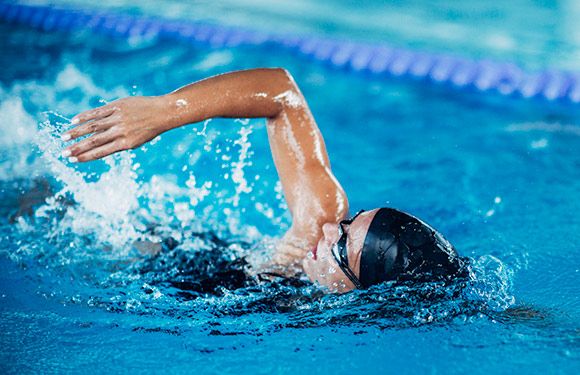
source : pinterest
Le crawl, également connu sous le nom de crawl, est peut-être le nage la plus courante et la plus efficaceElle implique un mouvement alterné continu des bras, combiné à un battement de jambes flottant, qui propulse le nageur vers l'avant rapidement et en douceur. La nage libre met l'accent sur les techniques respiratoires appropriées, le nageur tournant généralement la tête sur le côté pendant la phase de récupération des bras pour inspirer. De plus, maintenir une position aérodynamique est crucial, car cela réduit la traînée et permet une glisse efficace dans l'eau. L'efficacité et la vitesse de la nage libre en font la nage préférée des compétitions de natation, des triathlons et de la natation de remise en forme en général. Sa polyvalence en fait également une excellente nage à maîtriser pour les nageurs de tous niveaux.
Brasse
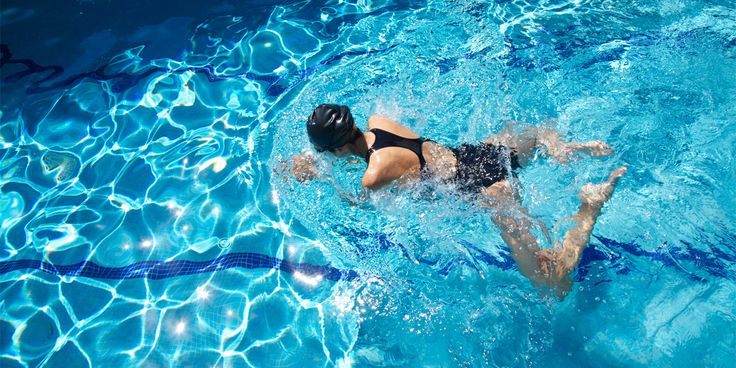
source : pinterest
La brasse est réputée pour son style gracieux et précis. Cette nage combine un mouvement simultané des bras et un battement de jambes en grenouille, ce qui la distingue des autres nages. Tandis que les nageurs exécutent un mouvement de balayage avec les bras, paumes tournées vers l'extérieur, leurs jambes effectuent un battement de jambes caractéristique : elles s'étendent vers l'extérieur puis plient les genoux pour rapprocher les pieds. Ce mouvement synchronisé assure une propulsion régulière dans l'eau. Son rythme tranquille la rend populaire auprès des nageurs amateurs et de ceux qui recherchent une expérience de nage décontractée, privilégiant le plaisir et le confort dans l'eau plutôt que la vitesse et l'intensité.
Dos crawlé
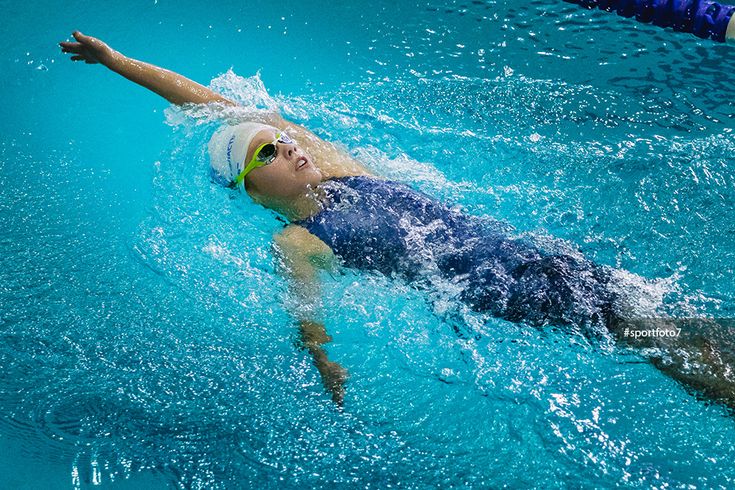
source : pinterest
Comme son nom l'indique, le dos crawlé est effectué en position allongée sur le dos, le visage et le corps tournés vers le haut. Cette nage se caractérise par un mouvement alterné continu des bras et un battement de jambes flottant, similaire à la nage libre, permettant une propulsion dans l'eau. La particularité du dos crawlé réside dans son caractère relaxant et apaisant : les nageurs flottent sans effort sur le dos, contemplant le ciel ou le plafond tout en se déplaçant avec fluidité sur l'eau. Cette nage offre une expérience de nage sereine, procurant une sensation de calme et de confort, le corps restant soutenu et flottant tout au long de la nage.
Brasse papillon
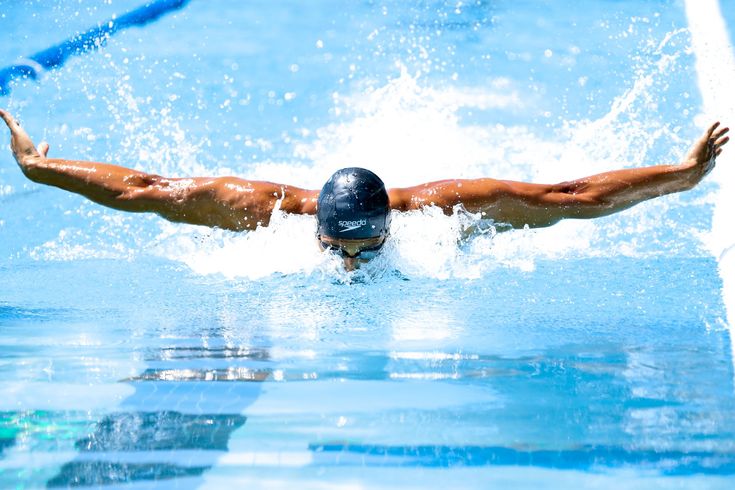
source : pinterest
La nage papillon est reconnue comme l'une des la natation la plus exigeante mais visuellement captivante Techniques. Elle se caractérise par un battement de jambes dauphin simultané et des mouvements des deux bras à l'unisson dans un mouvement de récupération au-dessus de l'eau. Cette nage exige une force considérable du haut du corps et une coordination précise pour réaliser son mouvement ondulatoire caractéristique dans l'eau. L'exécution gracieuse du papillon exige des nageurs une synchronisation de battements de jambes puissants avec des mouvements de bras puissants, créant une propulsion fluide et dynamique. Cette nage exigeante est souvent privilégiée par les nageurs de compétition pour sa vitesse et son aspect saisissant lors des courses et des performances.
Équipement et matériel de natation
Pour améliorer votre expérience et vos performances de natation, voici quelques conseils essentiels équipement et matériel de natation vous devriez considérer :
Maillots de bain

Maillots de bain Ce sont des vêtements spécialement conçus pour la natation et les activités aquatiques. Ils offrent confort, souplesse et maintien, permettant aux nageurs de bouger librement dans l'eau. Fabriqués dans des matières résistantes au chlore et à séchage rapide, les maillots de bain se déclinent en différents styles pour s'adapter à différentes préférences et activités.
Avantages des maillots de bain :
Les maillots de bain offrent une coupe ajustée qui réduit la traînée et améliore l'efficacité de la nage. Ils offrent le maintien et la couverture nécessaires, boostant la confiance et la performance. Leurs matières durables à séchage rapide résistent aux agressions du chlore et de l'eau salée, garantissant longévité et confort lors d'une utilisation prolongée.
Types et utilisateurs :
- Maillots de bain une pièce : Nageurs de compétition, préférences de modestie.
- Bikinis: Baignade récréative, bain de soleil.
- Maillots de bain/shorts de bain : Hommes, confort, polyvalence.
- Rashguards : Surfeurs, protection solaire supplémentaire.
Lunettes de natation

Lunettes de natation Ce sont des lunettes de protection conçues pour protéger les yeux de l'eau et améliorer la visibilité sous l'eau. Elles s'ajustent parfaitement autour des yeux, créant une étanchéité qui empêche l'eau de pénétrer et d'irriter les yeux pendant la baignade.
Avantages des lunettes de natation :
Les lunettes de natation améliorent la vision sous-marine, réduisent l'irritation oculaire due au chlore et à l'eau salée, et protègent des rayons UV nocifs. Elles améliorent la concentration et les performances en offrant une vision claire, ce qui les rend indispensables pour les nageurs amateurs comme pour les nageurs de compétition.
Types et utilisateurs :
- Lunettes de loisirs : Nageurs occasionnels, confort et protection de base.
- Lunettes de compétition : Nageurs professionnels, coupe profilée et faible traînée.
- Lunettes de vue : Nageurs malvoyants, verres personnalisés.
- Masques de natation : Plongeurs en apnée, plongeurs sous-marins, champ de vision plus large.
Bonnets de bain

Bonnets de bain Ce sont des couvre-chefs ajustés, fabriqués à partir de matériaux comme le silicone, le latex ou le lycra, conçus pour être portés par les nageurs. Ils aident à maintenir les cheveux hors du visage et à réduire la résistance, améliorant ainsi l'hydrodynamisme et protégeant les cheveux des dommages causés par le chlore.
Avantages des bonnets de bain :
Les bonnets de bain affinent la silhouette du nageur, réduisant la traînée et améliorant la vitesse. Ils protègent les cheveux du chlore et d'autres produits chimiques, les maintiennent à l'écart du visage et contribuent à l'hygiène de la piscine en limitant la chute des cheveux. Ils offrent également une certaine isolation en eau froide.
Types et utilisateurs :
- Bouchons en silicone : Nageurs récréatifs et compétitifs, durabilité et confort.
- Bonnets en latex : Nageurs de compétition, légers et coupe plus ajustée.
- Bonnets en lycra : Nageurs occasionnels, confort et facilité d'utilisation.
Planches de natation

Planches de natation Ce sont des planches flottantes et plates utilisées lors de l'entraînement de natation pour soutenir le haut du corps tout en permettant au nageur de se concentrer sur les mouvements des jambes. Fabriquées à partir de matériaux comme la mousse ou le plastique, elles aident les nageurs à pratiquer et à améliorer leur technique de battement de jambes.
Avantages des planches de natation :
Les planches isolent les muscles des jambes, permettant aux nageurs de renforcer et d'affiner leur technique de battement. Elles offrent flottabilité et stabilité, permettant de se concentrer plus facilement sur les mouvements des jambes sans se soucier des mouvements de bras ou de la respiration. Elles contribuent également à améliorer l'endurance et l'efficacité globale de la nage.
Types et utilisateurs :
- Planches de natation standard : Nageurs de tous niveaux, entraînement général et perfectionnement technique.
- Hybrides traction-coup de pied : Utilisation polyvalente comme planche de natation et bouée de traction, nageurs avancés.
- Planches de natation junior : Enfants et débutants, taille plus petite pour une manipulation facile.
- Planches ergonomiques : Nageurs de compétition, conçus pour le confort et une position optimale du corps.
Gilet de natation

Gilets de natation Ce sont des vêtements flottants portés autour du torse pour assurer la flottaison. Ils sont généralement fabriqués à partir de matériaux comme le néoprène ou la mousse et sont conçus pour aider les nageurs, en particulier les débutants, à maintenir leur flottabilité et à gagner en confiance dans l'eau.
Avantages du gilet de natation :
Les gilets de natation offrent une sécurité accrue grâce à leur flottabilité accrue, ce qui permet aux nageurs de rester à flot. Ils sont particulièrement utiles aux débutants et aux enfants, car ils renforcent leur confiance et permettent une expérience de natation plus détendue. Ils facilitent également l'apprentissage des bonnes techniques de natation en offrant un soutien.
Types et utilisateurs :
- Gilets de natation pour enfants : Jeunes nageurs, sécurité et renforcement de la confiance.
- Gilets de natation pour adultes : Débutants ou personnes ayant besoin de flottabilité, de confort et de soutien supplémentaires.
- Gilets de natation d'entraînement : Élèves nageurs, flottabilité réglable pour un apprentissage progressif.
- Gilets de natation récréative : Usage général, baignade de loisir et activités nautiques.
Comment nager : guide étape par étape
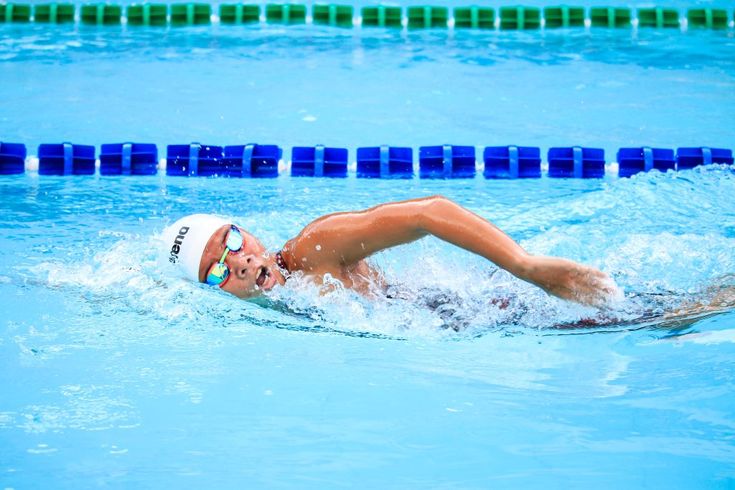
source : pinterest
Si vous êtes nouveau en natation ou si vous avez besoin d'un rappel, voici un guide étape par étape pour vous aider à démarrer et à progresser dans votre parcours de natation :
Étape 1 : Se sentir à l'aise dans l'eau
Avant de plonger en profondeur, il est essentiel de cultiver confiance et aisance dans l'eau. Commencez par vous tenir debout en eau peu profonde pour vous familiariser avec la sensation de l'eau autour de votre corps. Entraînez-vous à flotter sur le dos et le ventre, puis à immerger progressivement votre visage et à vous concentrer sur la détente et le contrôle de votre respiration. Cette pratique fondamentale permet non seulement de prendre conscience de l'eau, mais aussi de développer des compétences essentielles comme la flottabilité et la gestion de la respiration. Elle constitue une base solide pour progresser vers les eaux plus profondes et apprendre des techniques de nage plus avancées avec plus d'aisance et de confiance.
Étape 2 : Techniques de flottaison et de respiration
Maîtriser la flottaison est essentiel en natation, car cela améliore la stabilité et économise l'énergie. Entraînez-vous à flotter sur le dos et sur le ventre, en respirant lentement et de manière contrôlée pour maintenir votre flottabilité. Concentrez-vous sur une expiration douce dans l'eau et une inspiration régulière en tournant la tête pour respirer. Cette technique améliore non seulement votre capacité à flotter, mais aussi votre confort et votre confiance dans l'eau, vous préparant ainsi à des manœuvres et des mouvements de nage plus avancés.
Étape 3 : Mouvements de base des bras et des jambes
Une fois que vous maîtrisez la flottaison et la respiration, l'étape suivante consiste à intégrer les mouvements des bras et des jambes à votre technique de nage. Commencez par pratiquer les mouvements de base des bras, comme la nage libre. Tendez les bras devant vous, ramenez-les dans l'eau d'un mouvement continu et concentrez-vous sur le maintien d'une posture fluide. À mesure que vous maîtrisez les mouvements des bras, introduisez progressivement les mouvements des jambes en les synchronisant avec vos mouvements de bras de manière coordonnée. Cette phase d'apprentissage permet de développer la coordination et l'efficacité globales en nage, posant les bases pour maîtriser les différentes nages et améliorer vos compétences.
Étape 4 : Développer l'endurance et la résistance
À mesure que vous vous familiarisez avec les mouvements de base des bras et des jambes, il devient crucial de développer votre endurance et votre résistance dans votre routine de natation. Commencez par nager sur des distances plus courtes, puis augmentez progressivement la distance à mesure que vous progressez. Intégrez des entraînements fractionnés à vos séances, en alternant des allures plus lentes et plus rapides pour stimuler votre système cardiovasculaire et développer votre endurance. Il est essentiel de privilégier une bonne posture et une bonne technique tout au long de vos séances de natation afin de prévenir la fatigue et de minimiser la tension musculaire. En augmentant progressivement votre distance de nage et en intégrant des entraînements fractionnés, vous pouvez améliorer efficacement votre condition physique et vos capacités globales de natation au fil du temps.
Étape 5 : Techniques et exercices avancés
Une fois que vous aurez acquis de solides bases en natation, vous pourrez explorer des techniques et exercices avancés pour améliorer vos compétences. Il peut s'agir d'affiner vos techniques de nage, de pratiquer la respiration bilatérale, d'intégrer des virages retournés ou d'apprendre des nages avancées comme le papillon. La pratique d'exercices spécifiques à chaque style de nage peut vous aider à améliorer votre efficacité, votre vitesse et vos performances globales dans l'eau.
Précautions et conseils de sécurité
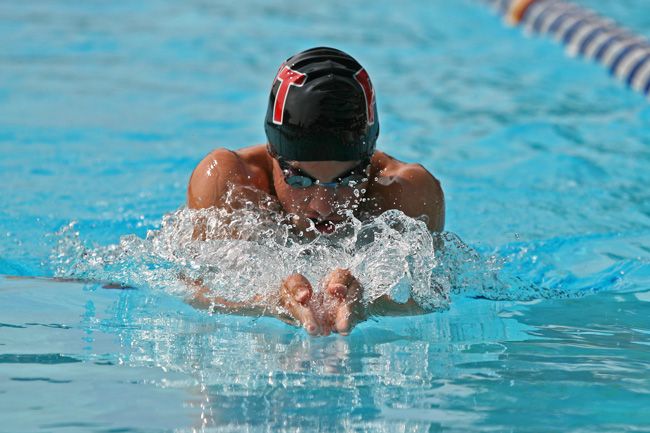
source : pinterest
La natation offre de nombreux bienfaits, mais il est essentiel de privilégier la sécurité lors de cette activité. Voici quelques précautions et conseils importants pour nager librement et en toute sécurité :
Importance des sauveteurs
Lorsque vous nagez dans des piscines publiques, sur des plages ou en eaux libres, il est essentiel de toujours nager dans des zones surveillées par des sauveteurs. Ces derniers sont des professionnels formés qui peuvent apporter une aide immédiate en cas d'urgence, comme une noyade ou tout autre incident aquatique. Leur présence renforce considérablement la sécurité des baigneurs en surveillant l'état de l'eau et en étant prêts à intervenir si nécessaire. Les sauveteurs connaissent également les dangers potentiels et peuvent prodiguer des conseils pour prévenir les accidents. Il est donc important de suivre attentivement leurs instructions et de respecter les panneaux d'avertissement ou les drapeaux indiquant des conditions d'eau dangereuses. Nager dans des zones surveillées par des sauveteurs garantit une expérience plus sûre et plus agréable pour tous.
Baignade dans les zones désignées
Nagez toujours dans des zones de baignade désignées, où l'état de l'eau est surveillé et jugé sûr. Ces zones sont généralement exemptes d'obstacles sous-marins et de dangers potentiels, ce qui les rend plus sûres pour les nageurs de tous niveaux. Les zones de baignade désignées sont régulièrement inspectées pour garantir l'absence de débris dangereux et la stabilité de la profondeur d'eau. Évitez de nager dans des zones à fort courant, à contre-courant ou à profondeur inconnue, car cela peut présenter des risques importants pour votre sécurité. En choisissant de nager dans des zones désignées, vous réduisez les risques de dangers imprévus et profitez d'une baignade plus sûre et plus relaxante.
Protection solaire
Nager en plein air expose votre peau aux rayons ultraviolets (UV) nocifs du soleil, qui peuvent provoquer des coups de soleil et des dommages cutanés à long terme. Pour une protection solaire optimale, appliquez une crème solaire waterproof avec un indice de protection élevé avant de nager et renouvelez-la toutes les quelques heures, surtout après avoir nagé. Portez également un chapeau à larges bords et des lunettes de soleil anti-UV pour protéger votre visage et vos yeux du soleil direct. Privilégiez l'ombre aux heures de pointe, généralement entre 10 h et 16 h, afin de minimiser l'exposition aux rayons nocifs. En prenant ces précautions, vous pourrez profiter de la baignade tout en réduisant considérablement les risques de coups de soleil et en protégeant votre peau des dommages.
Hydratation
Nager peut être épuisant, c'est pourquoi il est essentiel de rester hydraté tout au long de la séance. Même si vous n'avez pas soif dans l'eau, la déshydratation peut survenir. Pour maintenir un niveau d'hydratation adéquat, buvez de l'eau avant et après la baignade, et pensez à boire de petites gorgées d'eau pendant les pauses. Cela permet de compenser les pertes dues à l'effort physique et à l'exposition au soleil. Évitez les boissons caféinées ou sucrées, car elles peuvent contribuer à la déshydratation. En privilégiant l'hydratation, vous assurez à votre corps un état d'énergie et de performance optimal, vous permettant ainsi de profiter d'une expérience de natation plus sûre et plus agréable.
Conclusion
La natation n'est pas seulement une activité récréative, c'est aussi une forme d'exercice complète qui offre de nombreux bienfaits pour la santé. De l'entraînement cardiovasculaire à faible impact à l'amélioration de la souplesse et du tonus musculaire, la natation s'adresse à tous les âges et à tous les niveaux de forme physique. En comprenant les différents styles de nage, en vous procurant le matériel et l'équipement adéquats, en suivant un guide étape par étape et en privilégiant les précautions de sécurité, vous pouvez vous lancer dans une aventure aquatique qui vous apportera plaisir, forme et bien-être. Alors, qu'attendez-vous ? Plongez et découvrez l'art intemporel de la natation. Et n'oubliez pas : encouragez toujours les autres à se lancer dans cette activité enrichissante, car ses bienfaits vont bien au-delà de la surface de l'eau !
FAQ
1. Comment nager plus vite ?
Pour nager plus vite, concentrez-vous sur l'amélioration de votre technique et intégrez l'entraînement fractionné à votre routine de natation. Travaillez le positionnement de votre corps, les mouvements des bras et des jambes, ainsi que votre respiration. Pratiquez également des exercices qui mettent l'accent sur la vitesse et la puissance, et augmentez progressivement l'intensité et la distance pendant les séances.
2. Comment nager plus longtemps ?
Pour nager plus longtemps, développez progressivement votre endurance en intégrant des séances de natation plus longues à votre programme d'entraînement. Commencez par des distances plus courtes et augmentez progressivement la distance au fil du temps. Pratiquez l'entraînement fractionné pour améliorer votre endurance cardiovasculaire. Veillez à maintenir une bonne technique et à maintenir un bon rythme pour économiser votre énergie tout au long de votre nage.
3. Comment utiliser une planche ?
Pour utiliser une planche, tenez-la devant vous avec les deux mains, les bras le long du bord supérieur. Battez vos jambes en gardant le corps et la tête alignés, et maintenez un rythme régulier. Les planches sont idéales pour isoler le bas du corps et améliorer la force et l'endurance de vos jambes. Utilisez-les pour les exercices de battements de jambes ou pour reposer le haut du corps tout en vous concentrant sur le travail des jambes.
4. Que doit manger un nageur ?
L'alimentation d'un nageur doit être composée d'un mélange équilibré de glucides, de protéines et de bonnes graisses. Les glucides fournissent de l'énergie et doivent être consommés avant et après la baignade. On peut citer comme exemples les céréales complètes, les fruits et les légumes. Les protéines de qualité, comme les viandes maigres, le poisson, les œufs et les légumineuses, contribuent à la réparation et à la récupération musculaires. Les bonnes graisses, comme l'avocat, les noix et les graines, sont essentielles au bon fonctionnement de l'organisme et doivent être consommées avec modération.
5. Comment nager sans se boucher le nez ?
Pour nager sans se boucher le nez, pratiquez une bonne technique de respiration et contrôlez votre nez. Concentrez-vous sur l'expiration par le nez sous l'eau et l'inspiration par la bouche lorsque vous tournez la tête pour respirer. Avec de la pratique, votre corps s'adaptera naturellement à une respiration efficace pendant la nage, vous évitant ainsi de vous boucher le nez.
6. Qu’est-ce qui brûle le plus de calories : courir ou nager ?
La natation brûle généralement plus de calories que la course à pied. La résistance de l'eau sollicite davantage les muscles, ce qui entraîne une dépense calorique plus importante. Le nombre exact de calories brûlées varie en fonction de facteurs tels que l'intensité, la durée, le poids et le style de nage utilisé. En général, la natation sollicite davantage de groupes musculaires simultanément que la course à pied, ce qui en fait un entraînement complet efficace qui peut contribuer à améliorer la santé cardiovasculaire et le tonus musculaire.
